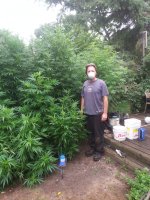gr865
Well-Known Member
When I collected rain water off my metal roof I always let it sit for a few days then drain the bottom couple of inches off to eliminate the dirt and solids that have settled to the bottom rain barrel.
My rain water is 0 ppm but has a pH near 7.5, so when I add it to my rez I always add CaliMagic to bring the ppm's to around 120 ppm then give it 24 hrs to stabilize before adding nutes. Add nutes then pH.
I still collect it and use it sometimes but I purchased a RO filter system, it adds Cal and Mag back into the system for flavor which makes the water around 110 to 130 ppm. I do love my RO system.
My rain water is 0 ppm but has a pH near 7.5, so when I add it to my rez I always add CaliMagic to bring the ppm's to around 120 ppm then give it 24 hrs to stabilize before adding nutes. Add nutes then pH.
I still collect it and use it sometimes but I purchased a RO filter system, it adds Cal and Mag back into the system for flavor which makes the water around 110 to 130 ppm. I do love my RO system.



